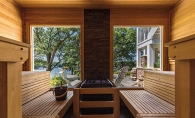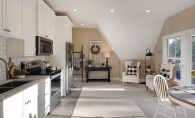Maureen Bellows and Barry Petit are reviving the modern-day farmhouse, transforming it from rural to suburban. Their firm, Vernacular Revival, focuses on simple, environmentally friendly designs, counter to the McMansion movement of recent decades. “We’re very different, but we’re going back to a very comfortable, older form,” Bellows says.
While the two urban designers have been friends for more than 30 years, Bellows and Petit only started working together in 2008. “Barry had retired, and we got together one day for coffee. I opened my big mouth and said, ‘Barry, you really need a book behind you,’” Bellows says. From there, Bellows and Petit began working on their book The Language of Design (Tower Publishing, 2012), which focuses on efficient planning for commercial architecture.
“We realized that the principles we focused on, like simplicity and harmony, really apply to residential homes. And residential design really needs some work,” Bellows says.
Bellows, who lives in Wayzata, attended Wellesley University and got a degree in urban design. She then received her master’s degree at the University of Minnesota. Petit, born and raised in Minneapolis, also went to the U as an undergrad in the school of architecture. He got his master’s degree in urban design from Cornell University.
When you visit the website for Vernacular Revival, some of first things you see are the concepts that are the foundation for the firm: simple elegance, regionalism, sustainability, hominess, maintenance and principles of good design like composition, color and scale.
With these concepts in mind, Bellows and Petit have worked with builders to create home designs that minimize environmental impact without compromising style. Beginning with the Modern Farmhouse model, they have now expanded their portfolio to include about 40 design packages.
“When we started designing the houses, we went to John Boyer of Boyer Building Corp. to make sure they were very simple and very buildable,” Bellows says.
Boyer, who built the first three homes for Vernacular Revival, says Bellows and Petit have a “refreshing take on rural American architecture ... Barry and Maureen seem to know how to keep the process simple, easy and fun.”
According to Bellows, there are some things that they try to keep consistent throughout their designs, like a front or side porch. “[The designs] are welcoming to guests and they really kind of cater to the new, yet very old notion of interacting with your neighbor,” Bellows says.
According to Bellows, there are also some things they avoid in their designs. “No double-height spaces. They waste heat and are essentially square feet you’re paying for but not getting use of.” She adds, “All along we’ve been doing clean architecture and are very concerned about the wastefulness in current architecture.”
Kristen Dascalos says this was one of the reasons she and her husband, Mike Emanuel, were drawn to Vernacular Revival during their search for a new home. “The houses that appealed to us aesthetically were usually much larger than we needed.”
Dascalos says she and her husband chatted with Petit to discuss their specific wants and needs. After exploring all the design plans, she says it was obvious which was perfect for them. “The interesting thing is that it wasn’t the one we thought we really wanted, but [Petit] greatly encouraged us to embrace the design that met our needs and budget.”
According to Bellows, affordability is something Vernacular Revival is committed to and able to achieve by going directly to a builder. “Our houses are not even half as much as what it would cost to get an architect-built home.”









